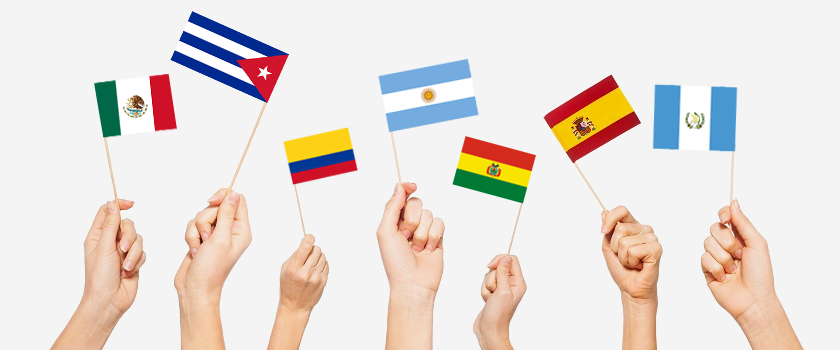How Many Countries Speak Spanish?
By: Eric Nelson Posted on Fri, 19-04-2019

Can you imagine how many countries speak Spanish? Exactly the same number of countries that you could have a good time if you knew Spanish! It might surprise you to know that the number of Spanish native speakers is the second largest in the whole world! And what is even more extraordinary is that Spain is not the one with the highest number of Spanish speakers.
A Little Bit about Spanish….
Not unlike Italian, French, or Romanian, Spanish has its roots in the common Latin. It originated from the places are currently known as Spain and Portugal to us, which was long ago the Iberian Peninsula. The standardized Spanish was born by the blend of common Latin and the Arabic Dialect spoken by the people who had conquered some parts of the region. It was also around this time that the Andalusian dialect of Spanish came to being as well, and is in fact still spoken in some parts of Spain.
People Who Speak Spanish around the World…
As mentioned already, Spanish is the second most spoken language in the world. It comes second only to Chinese, with 400 million native speakers. It even supersedes English which lands just after Spanish on the list with about 360 million native speakers.
Spanish Speaking Countries in the World
There are about 20 countries where you can go and flaunt your perfect Spanish, or get the fluency that you are looking for. Keep in mind not all of them use the Latin American Spanish, so you might want to brush up on a certain dialect before setting off on your journey.
Spain
About 48,146,134 people currently live in Spain, however, not all of them speak the same dialect. Around 74% speak a Castilian dialect of Spanish, constituting the majority, while 17% use Catalan, Galician is spoken only 7, and Basque only makes up 2% of the population.
Mexico
What most people don’t know is that despite being mainly a desert, Mexico also has rainforests and Mountains. They also might not know that from a population as huge as 121,736,809 people living in Mexico, the percentage of people that speak Spanish constitutes 94%.
Colombia
Located just around the northern coast of South America with access to both the Caribbean Sea and the Pacific Ocean, Colombia has a population of 46,736,728 people, and its official language is Spanish.
Argentina
With a population of about 43,431,886 people, Argentina is a country where many languages are spoken. However, Spanish remains to be its official language.
Peru
Peru is the hub for many native languages. Nonetheless, Spanish remains to be the official language of this country with a population of 30,444,999 people with 84% speaking the language.
Venezuela
Known best for the tallest waterfall in the world, Venezuela is located in northern South America. While many native languages are also spoken in this country of 29,275,460 people, Spanish remains its one official language.
Chile
Chile happens to be a long narrow country right between the Pacific Oceana and Argentina. From a population of 17,508,260 people living there, about 99.5% speak Spanish.
Ecuador
As cam be guessed by the name, Ecuador is located on the equator, just against the Pacific Ocean. Quechua is the widely spoken native language of the country Ecuador. But from a population of 15,868,369, almost 93% of people speak Spanish.
Guatemala
There is a rather clear division of people in Guatemala. From a population of 14,918,999 people living in the country, a clear 60% of people speak Spanish while the other 40% prefers to speak the native languages.
Cuba
Spanish is the official language of Cuba that has a population of 11,031,433 people. However, the point to be noted is that the Spanish spoken in Cuba has its own unique slang and pronunciation.
Bolivia
Mostly known for the famous Amazon rainforest, Bolivia is a country landlocked in South America. It has a population of about 10,800,882 people living there of whom 60.7% speak the Spanish language. Like any other country Bolivian Spanish also has a slight uniqueness to it with the phrases and expressions. Moreover, some native languages are also spoken by almost 36% of people.
Dominican Republic
The official language of the Dominican Republic is the Spanish language, but we are well aware that not all Spanish is the same. With a 10,478,756 population, the Dominican Spanish has its own pronunciation and slang.
Honduras
A country majorly mountainous, Honduras gets a lot of Caribbean coastline and just some chunk of the Pacific. With a population of 8,746,673 it has Spanish as its official language, however, native languages are also spoken there.
Paraguay
A country that is largely plains and landlocked in South America, Paraguay has a population of about 6,783,272 people, where two languages Spanish and Guarani share the same status of being an official language.
El Salvador
You will find El Salvador right between Honduras and Guatemala. The country consists of a population with 6,141,350 people. Even though Nawat is also spoken there, the official language of the country remains to be Spanish.
Nicaragua
Nicaragua falls in Central America falling between the Pacific and the Caribbean. With a population of 5,907,881 people living in the country, Nicaragua has almost 95.3% of the people speaking the Spanish language.
Costa Rica
Beaches, rainforest, or volcanoes? You name it, Costa Rica has it. Just as it has Spanish the official language of a population of 4,814,144 people.
Panama
The Panama Canal has really boosted the name of the country around the world. This country of 3,657,024 people also has Spanish as its official language. Although, not unlike many others, a number of native languages are also spoken there.
Uruguay
Uruguay is known for the beaches and neighborhoods like Colonia Del Sacramento. Around 3,341,893 people live in this country and it has Spanish as its official language.
Equatorial Guinea
From a population of 740,743 people living in Equatorial Guinea, 67.6% of the people speak the Spanish language while others speak Bubi, French, and Fang.

dxf: DXF is a CAD data file format developed by Autodesk for CAD data exchange between AutoCAD and other software. docx:
Read more
Mars Translation can help you extract the texts in a DXF file and convert them into a XML file so
Read more
Mars Translation can help you extract the texts in a DWG file and convert them into a Word file so
Read more
Africa is the second largest and second most populous continent. As recent statistics suggest, 1,486,275,887 is the current population of
Read more
No state on the western side of the globe can compare the strategic geographic location, diverse multilingual workforce, and attention
Read more
San Diego is California's second-largest city, and it has a population of 1.3 million from which three million residents are
Read more
Dallas is the largest state in Texas after Houston and San Antonio. It is the ninth most populous city in
Read more
In this day and age, users love to consume video content. Statistics show that almost 90% of all internet users
Read more
Virtual reality is transforming our imaginative worlds into existence. Since childhood, we used to create visionary kingdoms and act like
Read more